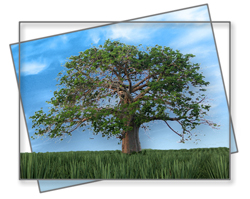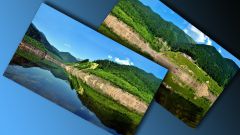Instruction
1
Dividing the information into multiple layers that form the composition, is, on the one hand, very convenient help in the work – each individual layer can be edited and changed independently of the others, on the other hand, this division sometimes prevents to produce just the same for all layers of the operation or the simultaneous use of filters.
Therefore, in order not to deprive himself of liberty, one must give the report, if you really need to merge the layers together, or enough of them only virtually "concatenate" as a single transformation, and then just enough to group and sort them by "daddy", not to get lost in the wilds of the composition.
If you need to make a simultaneous movement, reduction, reversal, reflection or other kind of geometric transformation of several layers – for example, each of them is one of the parts of a large object, and the object of this whole need to move or zoom, it can be done without any prejudice to their individual content.
Select a few layers you need, clicking over the lines with the names of the layers, and holding Ctrl, or Shift, in accordance with the standard rules of allocation of the elements adopted by the interface of the OS. When the list becomes highlighted several layers, the bottom of the list click on the icon with the image links of the chain. (This can also be done using the menu Layer>Link Layers) Now, layers of steel bound for the total transformation: shifting one, you'll move and everything associated with it, if you zoom in one stretch and the rest, etc. Can draw attention to the fact that now, when you select one layer at the end of the lines with the layers connected to it are displayed the icons of the chain. Accordingly, to break the connection of layers by repeatedly clicking on the icon at the bottom of the layer list. If not selected, all layers, from the United list will only exclude selected, the rest of the connection between them will remain.
Therefore, in order not to deprive himself of liberty, one must give the report, if you really need to merge the layers together, or enough of them only virtually "concatenate" as a single transformation, and then just enough to group and sort them by "daddy", not to get lost in the wilds of the composition.
If you need to make a simultaneous movement, reduction, reversal, reflection or other kind of geometric transformation of several layers – for example, each of them is one of the parts of a large object, and the object of this whole need to move or zoom, it can be done without any prejudice to their individual content.
Select a few layers you need, clicking over the lines with the names of the layers, and holding Ctrl, or Shift, in accordance with the standard rules of allocation of the elements adopted by the interface of the OS. When the list becomes highlighted several layers, the bottom of the list click on the icon with the image links of the chain. (This can also be done using the menu Layer>Link Layers) Now, layers of steel bound for the total transformation: shifting one, you'll move and everything associated with it, if you zoom in one stretch and the rest, etc. Can draw attention to the fact that now, when you select one layer at the end of the lines with the layers connected to it are displayed the icons of the chain. Accordingly, to break the connection of layers by repeatedly clicking on the icon at the bottom of the layer list. If not selected, all layers, from the United list will only exclude selected, the rest of the connection between them will remain.
2
You can combine layers in any other way, imprisoning them in a single group. Group layers in Adobe Photoshop is a type of nested folder structure that was adopted in computer systems. Layers can be grouped into a folder, the folder in turn, nested within other, etc. Advantages in the combination of several:
First, it creates order in the layer list – the unwanted contents of folders (groups) you can visually collapse so that they do not interfere with the review is, of course, will positively affect the usability and speed of finding needed objects in the list.
Second, the layer group has the General settings for the blending mode and transparency. Thus, for example, there is no need to do each layer is translucent, exposing the relevant parameter is the same every time for these layers can someday collect them into one group and put the total figure.
Thirdly, move, and transform objects in a group is as simple as "linked" using Link Layers, but the new method of communication more flexible and convenient. If you select in the layers list, group header, then produce the transformation will affect all the layers in it. But if the need arises, for example, to move individually any separate layer, you can do just purposefully selecting it in the list, without additional procedures – I recall that in the linked layers you would have had to first "unhook" it from the list and then re-enable to the list.
Fourth, the group has total transparency mask, so when you merge layers in a folder, there is no need to control the shape of each layer – once you "cut" a common mask.
To create a group folder is not difficult: it is necessary to click the appropriate icon at the bottom of the layers panel, or go through the menu Layer>Group Layers. To enable layers in a group by dragging them in the list to the group header, to extract, respectively, in passing beyond it.
First, it creates order in the layer list – the unwanted contents of folders (groups) you can visually collapse so that they do not interfere with the review is, of course, will positively affect the usability and speed of finding needed objects in the list.
Second, the layer group has the General settings for the blending mode and transparency. Thus, for example, there is no need to do each layer is translucent, exposing the relevant parameter is the same every time for these layers can someday collect them into one group and put the total figure.
Thirdly, move, and transform objects in a group is as simple as "linked" using Link Layers, but the new method of communication more flexible and convenient. If you select in the layers list, group header, then produce the transformation will affect all the layers in it. But if the need arises, for example, to move individually any separate layer, you can do just purposefully selecting it in the list, without additional procedures – I recall that in the linked layers you would have had to first "unhook" it from the list and then re-enable to the list.
Fourth, the group has total transparency mask, so when you merge layers in a folder, there is no need to control the shape of each layer – once you "cut" a common mask.
To create a group folder is not difficult: it is necessary to click the appropriate icon at the bottom of the layers panel, or go through the menu Layer>Group Layers. To enable layers in a group by dragging them in the list to the group header, to extract, respectively, in passing beyond it.
3
In the latest versions of Adobe Photoshop there is another mode of unification – the creation of multiple layers of so-called Smart Object. This is essentially the inclusion in one document of another independent, which opens in a separate window and can be edited and saved, after which the results of these operations will display in the main document. A big plus of this method of combining layers that have a Smart Object, you can connect the Filter property Gallery, that is to apply, so a single filter to multiple layers at once, and the contents of these layers remains intact, it is possible to modify how the parameters of the filters themselves, achieving the best result and, if necessary, to change themselves in layers, their mutual arrangement, the mode of inclusion in the composition, etc.
4
If the previous methods of combining the layers do not suit you, for example, for purely economic reasons – no editing layers is not exactly is implied all the complex filters have been applied and configured, the relative position of layers to change is not already, so there is no reason to have a battery of individual layers, consuming resources and disk space – they can just merge together to make them one simple layer.
To do this, select it in the list of layers we need, and in the context menu find the item, Merge the Layers (Merge layers), it is also possible to do this via command from the main menu Layer>Merge Layers, or pressing Ctrl+E.
To facilitate this operation, it is possible to choose and in the neighbourhood menu operation Merge Visible (Merge visible), then there's nothing to choose in the list of layers is not required in the single layer will merge everything that is currently displayed in the preview window.
It is also possible to combine the different layers are first assembled into one group in the context menu select Merge Group. Of course, the group will then cease to exist, and instead there will be a new layer.
To do this, select it in the list of layers we need, and in the context menu find the item, Merge the Layers (Merge layers), it is also possible to do this via command from the main menu Layer>Merge Layers, or pressing Ctrl+E.
To facilitate this operation, it is possible to choose and in the neighbourhood menu operation Merge Visible (Merge visible), then there's nothing to choose in the list of layers is not required in the single layer will merge everything that is currently displayed in the preview window.
It is also possible to combine the different layers are first assembled into one group in the context menu select Merge Group. Of course, the group will then cease to exist, and instead there will be a new layer.
5
Finally you can apply the most radical method is to select the menu Flatten Image. Then all the layer information will be lost: all that was in composition, with a single base layer, which, moreover, will be the background – ie circumcised and disappear all that went beyond the canvas. Such a step in practice to resort happens very seldom, because no one is immune from mistakes and to re-work on the reconstruction and the separation of the layers is an ungrateful business, besides, and sometimes technically impossible. Sometimes, inexperienced users believe that the implementation of Flatten Image, you need to have the whole final picture, which you can send to your friends or customers to post on the Internet, etc. It is not. File with composition just need to save in two different formats. One – the full document with further editing and corrections to a native format of Adobe Photoshop (menu File>Save or File>Save As) And the other file just for the Internet needs, for example, in the popular JPEG format, you can save more (for example, through the menu File>Save for Web, which has all the required settings for optimal saving an image for transmission via communication channels), with no special merging is not necessary – all will remain at one picture automatically. So you will always be insured from having to do additional re-work, and bitterly regret the lost information, opportunities and time.
Note
To merge a copy of all visible in Photoshop at the moment, layers or sets of layers in the bottommost visible layer (it may be new, specially created layer), hold down the Alt button from the Layer menu (Layer menu or the Layers palette), choose Merge Visible (Merge visible).
Useful advice
Before you merge the layers, create a higher layer with the Style a new layer and press Ctrl+E, the layer Style will turn into ordinary, but the effect of the applied style will not change.



